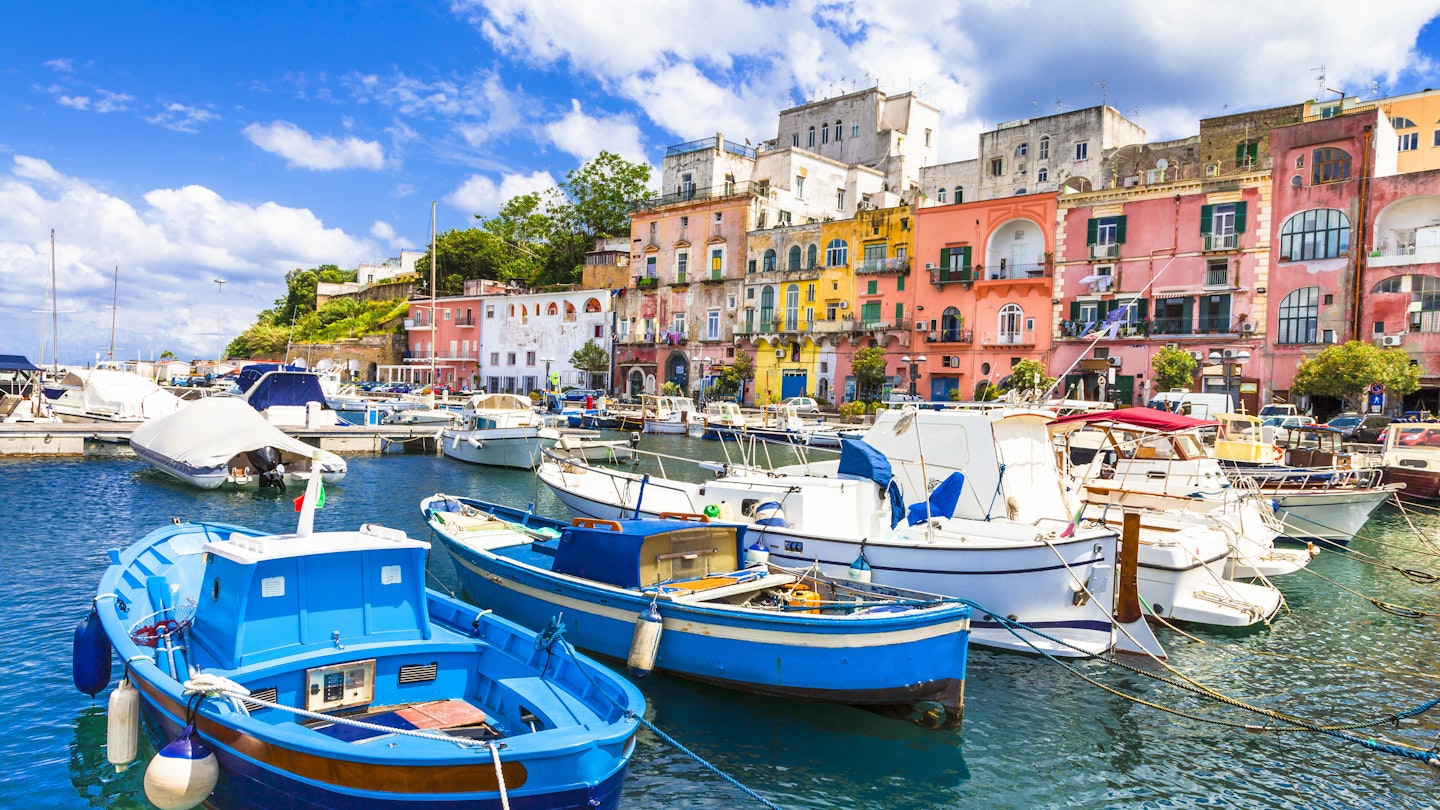
Procida has the same tumble of pastel houses, the same boat-speckled harbours, and the same bougainvillea-draped streets as Capri – but without the crowds. The Bay of Naples’s smallest island has somehow remained off the tourist trail, with a flurry of vacationing Neapolitans in August. Come September, the holiday-goers disappear, leaving near-empty volcanic beaches and silent old towns behind.
Big-screen appeal, without the pretensions
Gina Lollobrigida, Sophia Loren, and Elizabeth Taylor… Procida has been quietly captivating film stars for decades. The Bay of Naples’ best-kept secret, this tiny island is often bypassed for Ischia or Capri. While it doesn’t yield anywhere near the volume of column inches in travel guides like its better-known siblings, it maintains a serene charm that attracts discerning visitors. This hidden gem is just 40 minutes by boat from Naples.
Despite catching the eye of Anthony Minghella for his 1999 psychological thriller, The Talented Mr. Ripley, which filmed scenes in the cobblestoned streets of the 17th-century Marina di Corricella, it has avoided the typical tourist influx. This under-the-radar island means fewer crowds and more local experiences. The only sight of tourists might be RIBs (rigid-inflatable-boats) transporting Italian families from their boats to lunch at unassuming trattorias.
Seafood restaurants are nestled within traditional fishermen’s homes on the waterfront—originally painted in vivid colors for easy identification from the sea. This attention to detail has proven successful: weathered men frequently patch fishing nets on the harbourfront, calling to each other across the water. The colorful buildings cling to the slopes of a steep hill, crisscrossed with scalatinelli (staircase streets) that climb past peaceful piazzas. Elderly locals sit in the shade while the bells ring from the lemon-yellow church of Santa Maria delle Grazie. It is easy to imagine notable actors navigating these charming alleys, past old façades adorned with fluttering laundry.

Off the mass tourism trail
Life moves slowly on Procida’s 1.6 square miles. Tiny buses navigate the island’s narrow streets, crawling behind locals who are in no hurry to arrive. It may be faster to walk, but it’s not for the faint-hearted; roads are so narrow that locals often tuck in their wing mirrors to avoid damage, although scratches are still common.
Only a few hotels are scattered across Procida, primarily due to strict building regulations aimed at preventing overdevelopment. Visitors often choose to rent traditional fishermen’s houses in Marina di Corricella or at Marina Chiaiolella, the nearest village to Lido di Procida. The west-facing beach, known for its stunning sunsets, can get busy in August, filled mainly with holidaying Neapolitans and a few French tourists. Nevertheless, it remains easy to find a towel-sized spot on the charcoal-black sand, and the wait in restaurants mostly revolves around the catch of the day being freshly written on chalkboards.
Chiaiolella features an array of boutiques, pasticcerie, gelaterie, and excellent seafood restaurants along the waterfront. At the outdoor terrace of Ristorante da Mariano, waiters present enticing specials to eager diners—spaghetti ai ricci di mare (spaghetti with sea urchin), insalata di limone (lemon salad), and vino di falanghina. Next door, stylish young crowds gather at Ristorante Crescenzo, enjoying Neapolitan pizzas and refreshing draught beers, while playful bar staff greet friends arriving on Vespas.

Deserted beaches and pristine nature
Procida possesses stunning natural beauty that rivals Ischia’s, yet it often gets overlooked. The charm resides in its almost empty beaches with untouched sands, but reaching them can be an adventure. Steep staircases, marked by subtle spiaggia (beach) signs, are partially hidden behind clouds of vibrant bougainvillea. Tucked beneath a tangle of cacti and olive trees, sheer cliff faces dramatically descend to the dark sands. Waves lap at the shore while rickety wooden jetties extend into crystal-clear waters. These secluded beaches remain quiet during the week, flourishing with local families on the weekends.
The western beach, Pozzo Vecchio, features black sands and served as a backdrop for the 1994 film Il Postino, which portrays a postman’s friendship with exiled poet Pablo Neruda in the 1950s. The atmosphere feels timeless. On the island’s opposite side, boats transport diners from Marina di Corricella around the bay to Spiaggia Chiaia, where La Conchiglia is located on stilts above the beach. Here, guests indulge in exquisitely fresh seafood and fish dishes while taking in the view of Capri across the bay.
Over at Isola di Vivara, you’ll find another string of scenic beaches, but they do not capture the essence of this nature reserve. This tiny islet was shaped by an ancient volcanic eruption and provides remnants of a Bronze-Age Mycenaean settlement as well as fragments of ancient Greek pottery. Accessed by a long bridge, the reserve is privately owned but open to visitors on select days of the week.

Medieval old town and unspoiled viewpoints
Perched on the cliff edge, the medieval town of Terra Murata occupies the highest point on the island. Two belvederes (viewpoints) offer stunning views from this prime location. The west-facing terrace, flanked by iron cannons, provides breathtaking vistas of Corricella as well as the two rock jetties extending into the bay.
To the east, the stone terrace by the Abbazia San Michele Arcangelo gazes over the Gulf of Naples toward the hazy outline of Mt. Vesuvius and, further south, Capri. A section of Palazzo d’Avalos frames the view, especially stunning at golden hour. This 16th-century palace once housed the island’s ruling family before it became a prison in 1830, finally closing its doors in 1988. In this serene locale, you will find no selfie stick-wielding tourists, but only tranquil streets lined with butchers, bakers, and a small teal-colored bar, all pleasantly devoid of crowds.
For those seeking travel inspiration, tips, and additional content, exploring external resources can be beneficial for uncovering more experiences in destinations like Procida.




